Don't wanna be here? Send us removal request.
Text



Mineriada is part of the European Month of Photography 2025. The solo exhibition will be on view at Haus am Kleistpark Projekraum, Berlin, from 28.03–01.06.
-
'Mineriada’ is a sarcastic term that combines the Romanian word ‘miner’ with the suffix ’-iada’ as in ‘olimpiada’ (Olympics), quasi, the Miner’s Olympics. The work explores the societal division that plunged Romania into a decade of isolation. Its starting point is a series of ten photographs taken by Laub's father, depicting the devastation in Bucharest of June 1990. In a retrospective from Strasbourg, via Bucharest to Petrosani, Laub examines the sites of the events and the unspoken trauma of physical violence, when thousands of incited regime-loyal miners were brought in to the capital to brutally beat down students and the pro-European opposition. Despite a verdict by the European Court of Human Rights in 2014, the deadly attacks from those days remain unresolved. Based on research in justice discourses, Mineriada confronts the persistence of a suppressed past and raises awareness for recurrent conflicts in a polarized world.
-
Thanks to Barbara Esch Marowski



0 notes
Text


Coming up in 2026 at the Wende Museum, Culver City, Los Angeles, guest-curated by Sonia Voss.
Bucharest in the 1980s. Ceaușescu’s “systematization” program is in full swing in the Romanian capital: one-third of the historic center is being wiped out to make room for the megalomaniacal “People’s House” and create large avenues for official parades. It is said to be the largest peacetime destruction in the history of Europe.
Dictator Ceaușescu is particularly ruthless in his treatment of religious sites. Nevertheless, seven churches are spared and subjected to a process as incredible as it is absurd: they are lifted and placed on rails, then moved and hidden behind housing blocks, while several other sacred buildings, such as the Polish Synagogue, are surrounded and thus masked by imposing panel buildings. Withdrawn from the cityscape, isolated in the interstices of the disparate architecture that shapes Bucharest’s urban landscape today, they lead secret lives, precariously harboring unresolved memories.
Combining recent photographs by the artist with archival material, Mobile Churches is a critical and artistic inventory that aims to reveal a dramatic and little-known chapter in the urban and political evolution of the Eastern Bloc.
After numerous exhibitions in Europe, Mobile Churches is now being presented for the first time in the United States by the Wende Museum. This sequence constitutes part one in a trilogy of works by Laub (2013-17), followed by Last Christmas (of Ceaușescu) (2015-20) and Mineriada (2014-22). All three series were published as books by Kehrer Verlag (Heidelberg).
Historical material: Courtesy of E. I. Iordăchescu
0 notes
Text










The Robert Capa Contemporary Photography Center included the photobook Mobile Churches in the upcomimg exhibition PHOTO / ARTIST / BOOK The most exciting photobooks of the Central and Eastern Europe region, curated by Bea Istvánkó - Máté Lukács, ISBN+.
The exhibition opened on Nov 13, 2024 and goes through Feb 2, 2025.
Thanks to Radu Leşevschi & Bea.
https://capacenter.hu/en/kiallitasok/photo-artist-book-the-most-exciting-photobooks-of-the-central-and-eastern-europe-region/
-
Mobile Churches is about dictatorial fantasies that became urban realities, it is a critical inventory aiming at revealing a lesser-known yet dramatic urban and political chapter in Bucharest of the 1980s. Ceaușescu’s ‘systematization’ program is in full swing in the Romanian capital: one-third of the historic center – including churches and synagogues – has been wiped out to make way for imposing buildings and wide avenues intended to honor the regime. It is said to be the largest peacetime destruction in Europe. Despite Ceaușescu’s particularly dogged approach towards sacral buildings, seven churches are spared and undergo a process as incredible as it is absurd: they are lifted and placed on rails, then moved and hidden behind housing blocks, while several other buildings - such as the Polish Synagogue - got hermetically surrounded and thus masked by propagandistic panel buildings. Withdrawn from the cityscape, interpolated in the disparate architecture that shapes Bucharest��s urban landscape today, they live secret lives, holding unresolved memories of the past.
The photo book Mobile Churches, edited by Sonia Voss and published in 2017 by Kehrer Verlag, Heidelberg, is the first part of my Romania trilogy. Two essays, Mobile Churches. The non-sense of history by Sonia Voss, and City on Rails by Lotte Laub accompany the photo series.
The dummy of the photo book was nominated for the LUMA Dummy Book Award at Les Rencontres de la Photographie in Arles and later at Unseen Amsterdam. It is now part of the Archive of Les Rencontres de la Photographie d'Arles. The resulting photo book was launched at Paris Photo and later shortlisted for the FOLA Photo Book Award in Buenos Aires.
Design: Minami Shimakage Courtesy: Dr. ing. Eugeniu I. Iordăchescu
Exhibition views: Robert Capa Center, Budapest
0 notes
Text



Creatio ex nihilo (Bucuresti-Berlin: 1001 Articole), 2024/2015, chromogenic print on photo paper, 80x60 cm, from the eponymous video loop (00:01:00), 2015. Exhibition view: Alexandru Paul, 2/3 Galeria
𝗘𝘅𝗽𝗮𝗻𝗱𝗲𝗱 𝗦𝗽𝗮𝘁𝗶𝗮𝗹𝗶𝘁𝗶𝗲𝘀
Artists: David Barreiro, Bogdan Bordeianu, John Divola, Vladimir Florentin, Ion Grigorescu, Lina Ivanova, Anton Roland Laub, Ioana Marinescu, Andrei Mateescu, Alexander Rosenkranz, Emily Ryalls, Nadina Stoica, Anca Tintea
Curator: Laura Bivolaru
Project Coordinators: Claudia Retegan, Mihai Șovăială
Opening: September 5, 2024, at 18:00, 2/3 Galeria, Str. Franceza 4, Bucharest
September 6 – October 6, 2024
𝗩𝗶𝘀𝗶𝘁𝗶𝗻𝗴 𝗛𝗼𝘂𝗿𝘀: Thursday & Friday: 17:00-19:00 // Saturday & Sunday: 12:00-16:00
"Expanded Spatialities" problematizes the uniform image of the globalized city, asserting the human body as a creative agent of urban space. Through photography, collage, video, performance, and drawing, the city becomes a practiced space which residents and visitors alike occupy, build, remember and imagine across history.
The thirteen exhibiting artists use the past, both individual and collective memories, and their own bodies to expand and reinterpret urban space at the intersection of fiction and reality, between cartography and psychogeography. In their practices, the political, economic, and social aspects that impact the city are brought to light, investigated, and destabilised. Thus, the image is understood as more than just a mirror of the existing space; it becomes a tangible extension of past and future possibilities.
___________________
Partners: The Institute, Revista–Arta, Photography.Influx
Graphic Design: Vlad Mat
The cultural project is co-financed by the National Cultural Fund Administration (AFCN). It does not necessarily represent the position of AFCN. The AFCN is not responsible for the content of the project or how the results of the project may be used. These are entirely the responsibility of the funding recipient.
-------------------------
When I moved from Bucharest to Berlin, the sight of Karl Marx Avenue (formerly Stalin Avenue) immediately reminded me of the facades of Unity Boulevard (formerly Victory of Socialism Boulevard), so that memories of Bucharest gradually became associated with Karl-Marx-Allee. These memories, sediments, layers and maps still react to each other.
While photographing, I was reminded of Cicero's story of Simonides of Ceos, who discovered a new art of memory after a tragedy struck a banquet to which he had been invited to recite poetry. Just as the poet was called outside, the roof of the banquet hall collapsed, crushing all the guests beyond recognition. But Simonides was able to identify their mangled remains for family members because he remembered where they had sat at the table. Thus was born the mnemonic method of loci - places - which associates memories with specific places.
Karl-Marx-Allee is linked to the history of the former GDR, it was the flagship project of the East German reconstruction programme after the Second World War. It was here that the 17 June Uprising (the first anti-Stalinist uprising) was bloodily crushed by the Soviet Army in 1953.
In the 1980s, Bucharest had to pay a high price for the ruthless 'systematisation' of the city: the demolition of a third of the old historic area, including buildings in the classicist, art nouveau, modernist and art deco traditions, as well as synagogues and churches. It was one of the greatest urban destructions in the history of Romania, even compared to the destruction caused by the bombs of the Second World War. Thanks to the efforts of the intellectual elite both inside and outside the country, UNESCO was able to intervene in this urban massacre of architectural and collective memory. As a result of the international pressure, sacral buildings were no longer demolished, but the dictatorial absurdity persisted. While the population was surviving on the edge of subsistence, massive efforts were made to put entire churches on rails and move them, sometimes only a few metres from their original location: away from the streets, in the background, behind a series of new propagandistic buildings.
With the ‘systematisation’ programme and the construction of Bulevardul Victoria Socialismului (Victory of Socialism Boulevard) - today Bulevardul Unirii (Unity Boulevard) - the churches and synagogues were no longer visible from the street. They were erased from the official cityscape, but not from the memory of the locals.
0 notes
Text
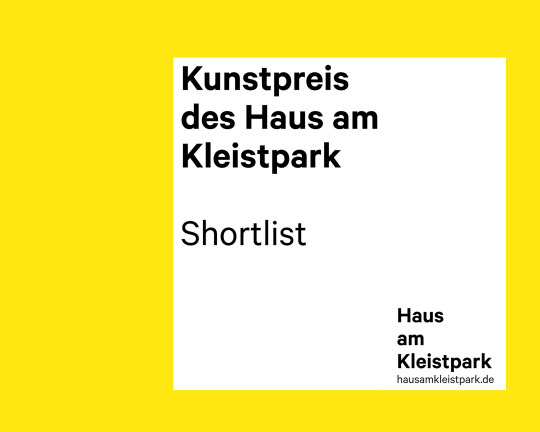
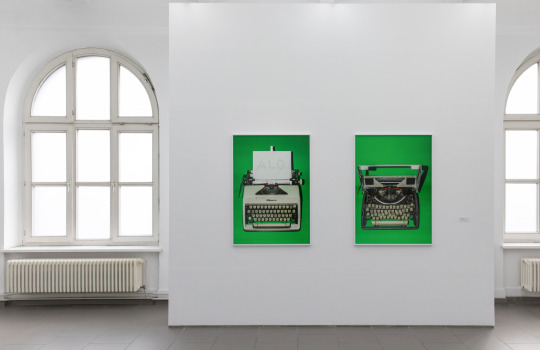
Punctum - Exhibition of the nominees for the Art Prize of Haus am Kleistpark
September 1 – October 1, 2023
With works by nominees: Claudia Angelmaier, Matthew Cowan and Jana Müller, Marta Djourina, Léo Faulhaber, Daniela Friebel, Ingo Gerken, Lukas Hoffmann, Anton Roland Laub, Noah Lübbe, Julian Netzer, Fiene Scharp, Aaron Scheer, Laura Suryani Thedja, Ivana de Vivanco, Manuela Warstat, Paul Wesenberg.
The jury, consisting of Julia Rosenbaum (jury chair), Frank Jimin Hopp, Bob Jones, Christoph Tannert and Barbara Esch Marowski selected from a total of 472 applications.
Photo: Amelie Losier; exhibition view: N.T., from the series LAST CHRISTMAS (of Ceausescu), 2015-2020; 2 Archival Pigment Prints on Photo Rag Baryta Paper, each 119×84 cm
The eponymous photo book was published in 2020 as a bilingual edition (De/En) at Kehrer Verlag, Heidelberg, edited by Frizzi Krella, with texts by Frizzi Krella and Lotte Laub. The monograph came in 2020 on the shortlist at the Athens Photo Festival, on the longlist of the German Photo Book Prize in 2021, and on the shortlist for the Photo-Book Award at the Belfast Photo Festival in 2022.
-
Every year in the 1980s around Christmastime, my father had to register his typewriter and the imprints of each key to submit them to the police (miliția). He hammered every single letter into his Olympia. In this way, the state archived the characteristic wear of all typefaces in the country and thus kept control over the written word. Any critique of the regime could be easily tracked and identified. But at Christmas 1989, the typewriter remained silent. In his last speech on December 21, 1989, from the balcony of the Central Committee in Bucharest, Romanian dictator Nicolae Ceausescu shouted "Alo" (Hello) into the microphone fifteen times. Again and again he restarted, but the crowd no longer responded to the "Conducator," to whom tribute poems had until recently been recited. The mood had changed. While the overthrow of the other East European dictatorships in 1989 was mostly peaceful, Romania’s Revolution ended in a bloodbath. Leaders called upon civilians to fight against nameless “terrorists”, leading to a great deal of friendly fire. 30 years after the system change, in December 2019, an EU resolution was passed, calling on the Romanian state to officially process the past events, an appeal that remains unfulfilled in Romania to this day. The events of those violent days remain shrouded in mystery and intrigue, leaving the question: was it a people’s uprising or a staged coup d’état? LAST CHRISTMAS (of Ceaușescu) focuses on questions of representation of history and institutional memory, three decades after the fall of the dictatorship.

0 notes
Photo

Fresh from the press:
Anne Bernou: Monuments de silence. Réappropriations mémorielles dans l’art contemporain, Edition Unes, Nice, 2023
On the works of Mathieu Kleyebe Abonnenc, Niels Ackermann, Sammy Baloji, Joachim Bandau, Guillaume Barborini, Christian Boltanski, Pascal Convert, Sylvain Couzinet-Jacques, Nicolas Daubanes, Raphaël Denis, Leo Fabrizio, Jochen Gerz, Felix Gonzalez-Torres, Marie Havel, Kiluanji Kia Henda, Elizaveta Konovalova, Vladimir Kozin, Anton Roland Laub, Amina Menia, Marianne Mispelaëre, Yan Morvan, Tania Mouraud, Ciprian Muresan, Deimantas Narkevicius, näutil, Mathieu Pernot, Anne Reijniers & Rob Jacobs, Emilija Skarnulyte, Thu-Van Tran, Paul Virilio, VOID (Arnaud Eeckhout & Mauro Vitturini)

Anton Roland Laub: from the series Mobile Churches, 2013–2017, archival pigment print on fine art Baryta paper, Bucharest
-
Résumé
Bunkers de la seconde guerre mondiale désaffectés sur les plages normandes, statues de l’ère soviétique déboulonnés, monuments coloniaux relégués dans l’oubli ; étranges silhouettes, à la fois familières et distantes. Qui décide du paysage mémoriel, de la représentation de la mémoire collective ? Dans Monuments de silence, Anne Bernou interroge et documente la mouvance de la mémoire et la réappropriation par des artistes contemporains de monuments publics du passé, aujourd’hui désinvestis, oubliés ou détruits. De Jochen Gerz et son travail autour des monuments aux morts à la falsification volontaire de la mémoire de Christian Boltanski, des captations de la falaise des Bouddhas géants de Bâmiyân détruits par les talibans de Pascal Convert aux déclinaisons de bunkers opérées par Raphaël Denis, d’Amina Menia et son utilisation des archives des monuments algériens à la réflexion de Thu Van Tran autour des origines et de l’exil, des statues de l’ex-monde soviétique mises en scène par Emilija Skarnulyte aux installations autour de la fragmentation et de l’oubli de Marianne Mispelaëre, plusieurs générations d’artistes figurent dans cet ouvrage, des plus connus aux plus émergents, chacun se penchant à sa façon sur la question de la mouvance de la mémoire et de l’identité ; préfigurant pour certains d’entre eux les mouvements sociaux qui ont surgi aux États-Unis notamment, avec le mouvement Black Lives Matters. Chacun sonde, détourne et réactive, avec son langage artistique propre, les tragédies du XXe siècle, le passé colonial, les dominations politiques, et les autoritarismes mémoriels dont la trace parfois monumentale s’impose dans l’espace public. Cette diversité des approches par des artistes qui se confrontent au passé européen plutôt que de l’oblitérer, démontre l’infini registre des regards et des compréhensions, reliant la dimension intime à la dimension historique, dans une réactivation de la mémoire collective génératrice de présent réconcilié. Cet ouvrage porte sur le travail des artistes Mathieu Kleyebe Abonnenc, Niels Ackermann, Sammy Baloji, Joachim Bandau, Guillaume Barborini, Christian Boltanski, Pascal Convert, Sylvain Couzinet-Jacques, Nicolas Daubanes, Raphaël Denis, Leo Fabrizio, Jochen Gerz, Felix Gonzalez-Torres, Marie Havel, Kiluanji Kia Henda, Elizaveta Konovalova, Vladimir Kozin, Anton Roland Laub, Amina Menia, Marianne Mispelaëre, Yan Morvan, Tania Mouraud, Ciprian Muresan, Deimantas Narkevicius, näutil, Mathieu Pernot, Anne Reijniers & Rob Jacobs, Emilija Skarnulyte, Thu-Van Tran, Paul Virilio, VOID (Arnaud Eeckhout & Mauro Vitturini)
https://www.fnac.com/a17486291/Anne-Bernou-Monuments-de-silence
1 note
·
View note
Photo



On the occasion of Gallery Weekend 2023, Sculplobe e.V. together with dittrich & schlechtriem present the group show a/r/rival, curated by Daniel Hölzl at Lobe Block, Berlin. a/r/rival is on view for two days, on Wednesday, April 26, 2–9 PM, with an opening reception from 6 to 9 PM, and on Thursday, April 27, 10 AM–6 PM.
With works by Hannah Blumas, Julian Charrière, Marta Dyachenko, Abie Franklin, Richard Green, Andreas Greiner, Daniel Hölzl, Klaus Jörres, Anton Roland Laub, Simon Mullan, Florian Neufeldt, Monty Richthofen, Marie von Heyl and Jonas Wendelin.
The exhibition a/r/rival questions individual human sensations associated with the concept of arrival. In the context of the exhibition, the concept of arrival is deliberately blurred. At the same time, the title of the exhibition also alludes to a rivalry of things and states.
An arrival always speaks of a new beginning, as well as of leaving something behind. Thus, there is always a rivalry between place A and place B - a rivalry between the feelings and memories associated with the old and the known, and those directed towards the potential of new beginnings. The exhibition looks at those very tensions that fan out in the in-between of states, places, and spheres: from home to sanctuary, from indoors to outdoors, from the depths of the earth to the heights and back to earth. Finally, in a/r/rival we encounter various materials in different forms, contexts and functions - materials appear as messengers of a new beginning and at the same time as witnesses of the past.
1 note
·
View note
Photo




Bucharest, The Museum of Recent Art / MARe, exhibition detail view, 5 color prints on wood 60x60cm, 2 b/w prints on wood 187,5x125cm
SEE WHAT. Photography in Romania after 2000 - a group exhibition curated by Michele Bressan and Ioana Iuna Serban
With works by: Lucian Bran, Michele Bressan, Valeriu Catalineanu, Ioana Cirlig, Bogdan Girbovan, Emoke Kerekes, Anton Roland Laub, Virgina Lupu, Andrei Mateescu, Patricia Morosan, Andrei Nacu, Mihai Sovaiala
The show opens with a catalogue launch on February 8 at 7 pm and goes through May 8, catalogue texts by Michele Bressan, Erwin Kessler and Ioana Iuna Serban.
Catalogue and poster design: Mihai Sovaiala
-
One of my concerns is the mnemonic function of places, how memories are bound to places. Mobile Churches is about dictatorial fantasies that became urban realities, it is a critical inventory aiming at revealing a lesser-known yet dramatic urban and political chapter in Bucharest of the 1980s. Ceaușescu’s ‘systematization’ program is in full swing in the Romanian capital: one-third of the historic center – including churches and synagogues – has been wiped out to make way for imposing buildings and wide avenues intended to honor the regime. It is said to be the largest peacetime destruction in Europe. Despite Ceaușescu’s particularly dogged approach towards sacral buildings, seven churches are spared and undergo a process as incredible as it is absurd: they are lifted and placed on rails, then moved and hidden behind housing blocks, while several other buildings - such as the Polish Synagogue - got hermetically surrounded and thus masked by propagandistic panel buildings. Withdrawn from the cityscape, interpolated in the disparate architecture that shapes Bucharest’s urban landscape today, they live secret lives, holding unresolved memories of the past.
The photo book Mobile Churches is the first part of my trilogy, published in 2017 by Kehrer Verlag, Heidelberg. Two essays, "Mobile Churches. The non-sense of history" by Sonia Voss, and "City on Rails" by Lotte Laub accompany the photo series.
https://www.kehrerverlag.com/en/anton-roland-laub-mobile-churches
2 notes
·
View notes
Photo
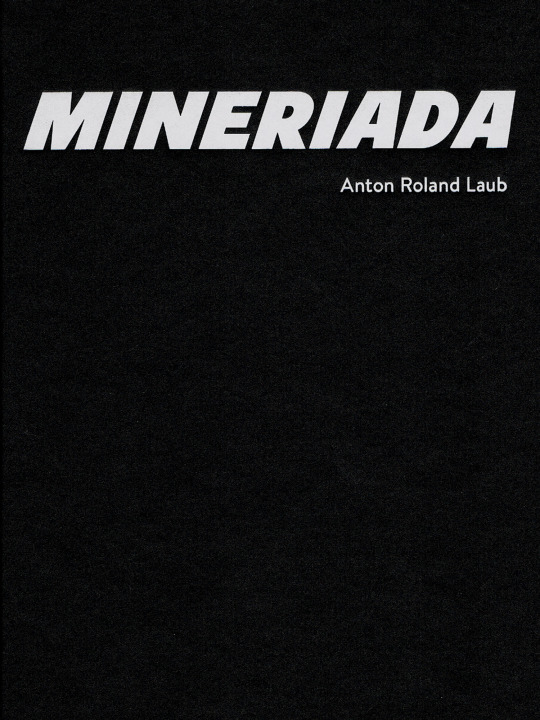
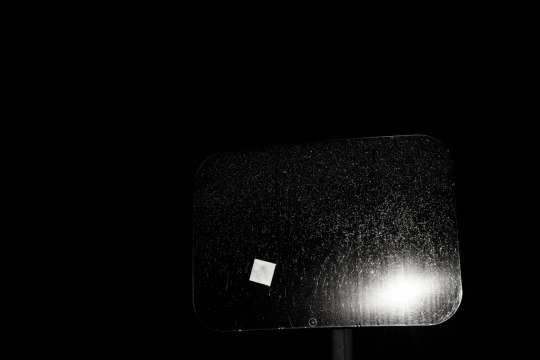
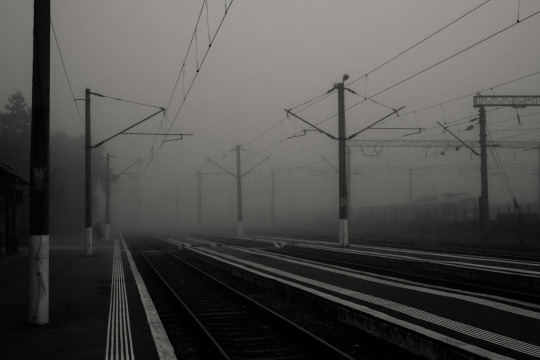
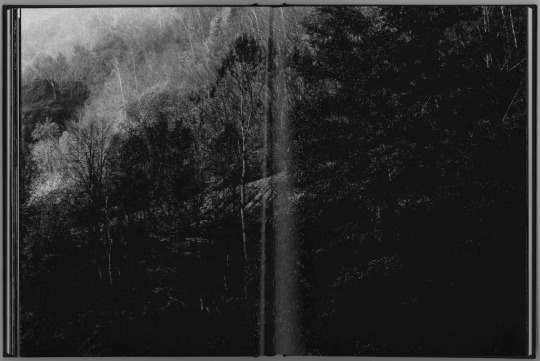
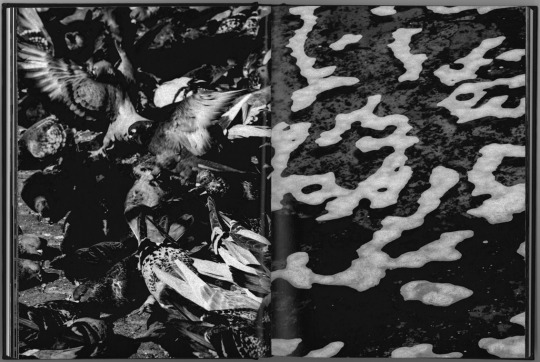
"Films move forward like trains in the night, says François Truffaut in Day for Night, making an incisive analogy between the long succession of train carriages passing through a dark landscape and the implacable forward motion of stories, which – in contrast to real life – tolerate no down time. One could say the same thing about memory – except that memory involves a backward motion: Its tension is directed towards an often uncertain past rather than a pre-determined dénouement. In the night, as in the clatter of memories, time loses its measurable and regular dimension. It jumps from one image to the next, mindless of the years that separate them; it manifests itself in sudden apparitions and accelerations. Memories surface without warning, deformed by their speed, transformed by virtue of inscrutable connections and bifurcations. Sometimes they derail; at any moment the past and the present may collide."
– from the essay Night Train by Sonia Voss "Saturn Devouring his Son is one of Goya's Black Paintings. Saturn devours each of his new-born sons in an attempt to forestall a prophesy that one day he will be driven from his own kingdom by his son. […] Intergenerational cannibalism, as handed down through the myth of Saturn, throws its shadow on the mineriad, which brought hope for a democratic upheaval in Romania to an abrupt end. Under the guise of 'original democracy', the monster that destroys the hope for a new way of living turns out to be the old leadership obsessed by its efforts to maintain power. The shocking experience of the mineriad would ensure the continued existence of the old power elite. […] The events in Romania are not an isolated phenomenon. In the Romanian press, the brutal attack on the US Capitol on 6 January 2021 was likened to the mineriad."
– from the essay Saturn Devours its Children by Lotte Laub
'Mineriada' is a sarcastic term that combines the Romanian word ‘miner’ with the suffix ’-iada’ like in ‘olimpiada’ (Olympics), quasi, the Miner’s Olympics. As a teenager, I took part in the pro-European demonstrations and experienced some of the dramatic events myself.
MINERIADA addresses the societal division that led Romania into a decade of isolation. The starting point are ten photographs taken by my father depicting the devastation in Bucharest of June 1990. In a retrospective from Strasbourg, via Bucharest to Petrosani, the work examines the sites of the events and the unspoken trauma of physical violence, when thousands of instigated regime-loyal miners were brought in to the capital by trains and buses to brutally bludgeon students and the pro-European opposition.
Despite a verdict by the European Court of Human Rights in 2014, the aggressions from those days remain unresolved, and the dead have not been atoned for.
Based on research into justice discourses, MINERIADA addresses the latency of the suppressed past and raises awareness of recursive events, in a world that is once again becoming increasingly polarized.
Following Mobile Churches, 2017, and LAST CHRISTMAS (of Ceausescu), 2020, MINERIADA, 2022, is the last part of my trilogy, published by Kehrer Verlag, Heidelberg. The monograph was realized with the support of the Visual Arts Research Stipend of the Senate Department for Culture and Europe, Berlin, and the Publication Grant of the Stiftung Kulturwerk, Bonn. In October 2023, the book was awarded the bronze medal in the Fine Art category of the 2023-24 German Photo Book Prize, and was on view at Städtische Galerie, Regensburg and Goethe-Institut, Hong Kong, among other places.
https://www.kehrerverlag.com/en/anton-roland-laub-mineriada
1 note
·
View note
Photo





Die Gruppenausstellung it takes time to build and a second to wreck it, kuratiert von Matilda Felix, eröffnete am 8. Juli in der Städtischen Galerie Delmenhorst, Haus Coburg.
Mit: Eiko Grimberg, Susanne Keichel, Anton Roland Laub, Eva Leitolf, Oliver Ressler, Julian Röder
09. Juli – 06. November 2022
2022 befindet sich Europa in einer krisenhaften Situation, die – durch eine Pandemie, durch Krieg, Migration und durch Klimaerwärmung ausgelöst – eine Zeitenwende oder einen Kipp-Punkt bedeuten kann. Fotografien sind allerorten zum zentralen Kommunikationsmittel geworden, sei es in politischer Inszenierung, in der Berichterstattung oder auf den Social-Media-Kanälen. Bilder, die schneller zirkulieren als sie verifiziert werden können, vermitteln ihre Botschaften sehr viel unmittelbarer und effektiver als Texte. Aber während die Geschwindigkeit der Kommentare und der impulsiven Reaktionen darauf kaum noch nachvollziehbar ist, behaupten sich im künstlerischen Feld Positionen, die langfristig – oft über Jahre hinweg – einem Thema folgen und sich den Luxus des Nachdenkens und der Recherche erlauben. Das Ergebnis sind konzentrierte Serien, die differenzierte Zusammenhänge und Kontexte herstellen. Reisen und Forschungen bilden die Arbeitsgrundlage für die in der Ausstellung vorgestellten Künstlerinnen und Künstler. Eiko Grimberg, Susanne Keichel, Anton Roland Laub, Eva Leitolf, Oliver Ressler und Julian Röder haben gemeinsam, dass sie seriell mit dem fotografischen Medium arbeiten und sich einem Gegenstand langfristig verpflichtet fühlen. Sie untersuchen ihr Thema nicht nur sehr genau, sondern verfolgen auch Veränderungen und finden visuelle Übersetzung für gesellschaftliche Entwicklungen. Sie begeben sich an Orte, die Konflikte an die Oberfläche treten lassen. Aber anders als bei investigativen Dokumentarfotografien räumen sie auch Möglichkeiten ein, das Bild anzuzweifeln. Es sind subjektive Bilder und Zusammenhänge, die sie anbieten. Die Fotografien beweisen hier nichts, sie eröffnen einen gedanklichen Freiraum und laden zum Nachdenken über die Verfasstheit europäischer Gesellschaften ein.
Die Ausstellung wird von der Stiftung Niedersachsen, der Katrin und Uwe Hollweg Stiftung und dem Niedersächsischen Ministerium für Wissenschaft und Kultur unterstützt.
Fotodrucke auf Holz, 8 color je 60x60cm und 3 s/w je 187,5x125cm, 4 gerahmte color Archival Pigment Prints je 50x35cm
Das Fotobuch Mobile Churches, erschienen beim Kehrer Verlag, Heidelberg, wurde herausgegeben von Sonia Voss, mit Textbeiträgen von Sonia Voss und Lotte Laub
0 notes
Photo



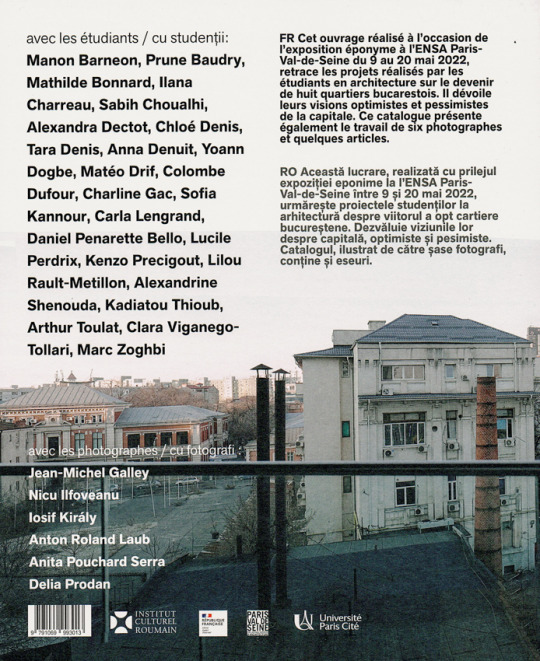
3 diptychs from the series (Not Every Building on) The Victory of Socialism Boulevard, 2014, are on view during the group exhibition Bucarest, une ville ouverte, curated by Philippe Simon and Jérémy Vercken de Vreuschmen at the École nationale supérieure d’architecture Paris-Val de Seine, Paris.
With: the students of ENSA and Jean-Michel Galley, Nicu Ilfoveanu, Iosif Király, Anton Roland Laub, Delia Prodan, Anita Pouchard Serra.
The exhibition catalogue is published by the Romanian Cultural Institute, Paris.
0 notes
Photo
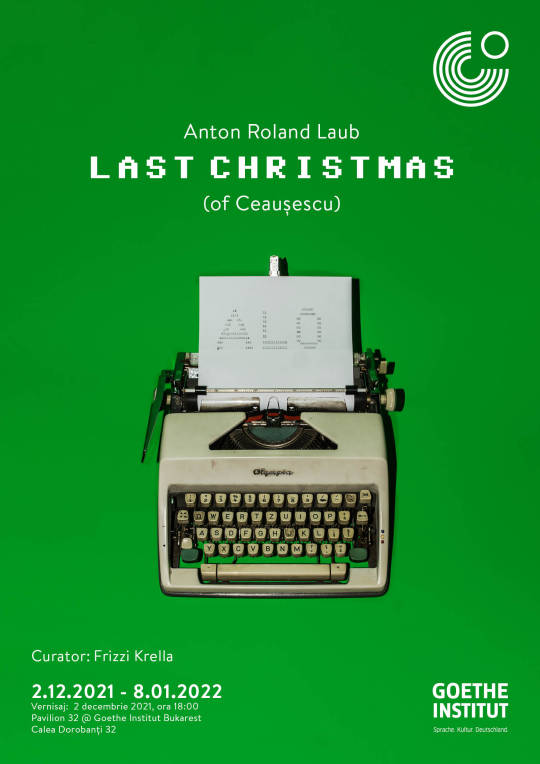
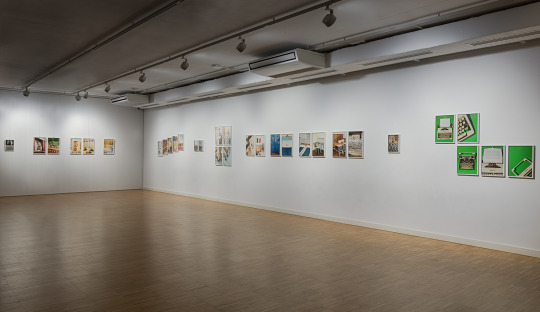
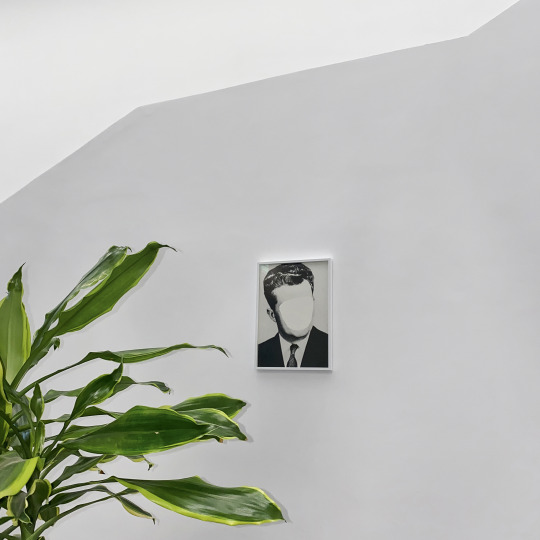
Solo exhibition at Goethe-Institut Bucharest, Dec 2021–Jan 2022, curated by Frizzi Krella. With the kind support of Goethe-Institut Bukarest, thanks to Institute Director Dr. Joachim Umlauf & team.
LAST CHRISTMAS (of Ceaușescu) poses questions about the justice discourse in Romania and examines the dysfunctional dynamics and the institutional memory of the Romanian revolution three decades later. I visited museums that bear witness to the events of that time and questioned their transparency, or to what extent it is merely claimed. The focus is directed at the agency of things, at what they reveal or conceal, investigating constructions of power and the latency of controversy related to injustice and disorientation.
Dealing with the fall of the Romanian dictator Ceaușescu on Christmas Day 1989, three places are at the fore: Ceaușescu’s private house in Bucharest, the execution site in Târgoviște, and Casa Poporului, the never inaugurated ruler’s palace, for which an entire historical neighbourhood was demolished. How do they look back on us today? All three are ‘traumatised’ places, silent witnesses of an undead past, in which the echo of the personality cult still resonates today. During the 1980s there were rumours of a bathroom of pure gold that was supposedly to be found in Ceaușescu’s home. When I first entered it, I was immediately reminded of Lee Miller's photograph. From the empty bathroom, that can now be visited, the banality of evil looks back at the viewer.
Every year in the 1980s around Christmastime, my father had to register his typewriter and the imprints of each key to submit them to the police (miliția), who archived the profiles of every single typewriter in the country. But not at Christmas 1989. On December 22, Nicolae and Elena Ceaușescu are arrested at Târgoviște, of all places, the city where Vlad the Impaler alias Dracula once resided. On Christmas Day, the couple is sentenced to death in a brief show trial. The death sentence is carried out immediately. On December 26, the Christmas mass was broadcast live on Romanian TV for the first time. On the same day, the images of the execution go around the world.
30 years after the system change, an EU resolution was passed, calling on the Romanian state to officially process the past events. While the overthrow of the other East European dictatorships in 1989 was mostly peaceful, Romania’s Revolution ended in a bloodbath. Leaders called upon civilians to fight against nameless “terrorists”, leading to a great deal of friendly fire. The events of those violent days remain shrouded in mystery and intrigue, leaving the question: was it a people’s uprising or a staged coup d’état? “Romania’s failure to address the unatoned crimes of 1989 in a legal process weighs on the state like a curse. [...] The unexplained crimes still rumble underground. Perpetrators who have not been called to account remain a threat, like the undead, sucking the blood and thus the life-force of the living, as the vampire myth puts it." (from the essay In the Forest of the Impaled by Lotte Laub)
The eponymous photo book was published as a bilingual edition (De/En) at Kehrer Verlag, Heidelberg, edited by Frizzi Krella, with texts by Frizzi Krella and Lotte Laub. The monograph came in 2020 on the shortlist at the Athens Photo Festival, on the longlist of the German Photo Book Prize in 2021, and on the shortlist for the Photo-Book Award at the Belfast Photo Festival in 2022.
Poster Design: Marius Weber
0 notes
Photo

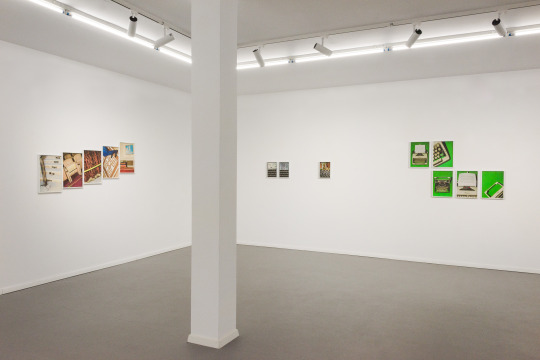


LAST CHRISTMAS (of Ceaușescu), solo exhibition, Galeria Aparte, Iași, curated by Matei Bejenaru, artist and professor at Facultatea de Arte vizuale si Design. With the collaboration and kind support of: Universitatea Națională de Arte George Enescu, Centrul Cultural German and Goethe-Institut. Thanks to: Matei Bejenaru, Madalina Spinaru, Catalin Soreanu, Lavinia German, Vlad Onescu, Ana Maria Palimariu, Frizzi Krella, Lotte Laub
LAST CHRISTMAS (of Ceaușescu) poses questions about the justice discourse in Romania and examines the dysfunctional dynamics and the institutional memory of the Romanian revolution three decades later. I visited museums that bear witness to the events of that time and questioned their transparency, or to what extent it is merely claimed. The focus is directed at the agency of things, at what they reveal or conceal, investigating constructions of power and the latency of controversy related to injustice and disorientation.
Dealing with the fall of the Romanian dictator Ceaușescu on Christmas Day 1989, three places are at the fore: Ceaușescu’s private house in Bucharest, the execution site in Târgoviște, and Casa Poporului, the never inaugurated ruler’s palace, for which an entire historical neighbourhood was demolished. How do they look back on us today? All three are ‘traumatised’ places, silent witnesses of an undead past, in which the echo of the personality cult still resonates today. During the 1980s there were rumours of a bathroom of pure gold that was supposedly to be found in Ceaușescu’s home. When I first entered it, I was immediately reminded of Lee Miller’s photograph. From the empty bathroom, that can now be visited, the banality of evil looks back at the viewer.
Every year in the 1980s around Christmastime, my father had to register his typewriter and the imprints of each key to submit them to the police (miliția), who archived the profiles of every single typewriter in the country. But not at Christmas 1989. On December 22, Nicolae and Elena Ceaușescu are arrested at Târgoviște, of all places, the city where Vlad the Impaler alias Dracula once resided. On Christmas Day, the couple is sentenced to death in a brief show trial. The death sentence is carried out immediately. On December 26, the Christmas mass was broadcast live on Romanian TV for the first time. On the same day, the images of the execution go around the world.
30 years after the system change, an EU resolution was passed, calling on the Romanian state to officially process the past events. While the overthrow of the other East European dictatorships in 1989 was mostly peaceful, Romania’s Revolution ended in a bloodbath. Leaders called upon civilians to fight against nameless “terrorists”, leading to a great deal of friendly fire. The events of those violent days remain shrouded in mystery and intrigue, leaving the question: was it a people’s uprising or a staged coup d’état? “Romania’s failure to address the unatoned crimes of 1989 in a legal process weighs on the state like a curse. […] The unexplained crimes still rumble underground. Perpetrators who have not been called to account remain a threat, like the undead, sucking the blood and thus the life-force of the living, as the vampire myth puts it.“ (from the essay In the Forest of the Impaled by Lotte Laub)
The eponymous photo book was published as a bilingual edition (De/En) at Kehrer Verlag, Heidelberg, edited by Frizzi Krella, with texts by Frizzi Krella and Lotte Laub. The monograph came in 2020 on the shortlist at the Athens Photo Festival, on the longlist of the German Photo Book Prize in 2021, and on the shortlist for the Photo-Book Award at the Belfast Photo Festival in 2022.
0 notes
Photo

36 slides from the series LAST CHRISTMAS (of Ceausescu) are part of the twin-exhibitions Image fantôme catalyzed by Nadia Lichtig’s artistic residency in Romania, at the invitation of the Goethe-Institut Bucharest and Anca Poterașu Gallery.
“The exhibitions explore the uncanny and the inexpressible, where fear, memory, forgetfulness become part of interdependent cultural and personal histories. Memory is an action that is to be performed, put in motion. In this sense, images are more than passive recorders of events: they belong to a wider universe of affects, as connected and reactive threads of individual and collective lives.” (from the curatorial text by Cristina Stoenescu).
The twin-exhibitions open on Sep 07, 6 pm at Goethe-Institut Bucharest and on Sep 08, 6 pm at Anca Poterașu Gallery, Bucharest, with: Irina Botea Bucan and Jon Dean, Larisa Crunteanu, Stoyan Dechev, Orit Ishay, Radu Jude, Iosif Király, Anton Roland Laub, Nadia Lichtig, Astrid Rottman, Maya Schweizer, Decebal Scriba, Alexandru Solomon.
LAST CHRISTMAS (of Ceaușescu) poses questions about the justice discourse in Romania and examines the dysfunctional dynamics and the institutional memory of the Romanian revolution three decades later. I visited museums that bear witness to the events of that time and questioned their transparency, or to what extent it is merely claimed. The focus is directed at the agency of things, at what they reveal or conceal, investigating constructions of power and the latency of controversy related to injustice and disorientation.
Dealing with the fall of the Romanian dictator Ceaușescu on Christmas Day 1989, three places are at the fore: Ceaușescu’s private house in Bucharest, the execution site in Târgoviște, and Casa Poporului, the never inaugurated ruler’s palace, for which an entire historical neighbourhood was demolished. How do they look back on us today? All three are ‘traumatised’ places, silent witnesses of an undead past, in which the echo of the personality cult still resonates today. During the 1980s there were rumours of a bathroom of pure gold that was supposedly to be found in Ceaușescu’s home. When I first entered it, I was immediately reminded of Lee Miller’s photograph. From the empty bathroom, that can now be visited, the banality of evil looks back at the viewer.
Every year in the 1980s around Christmastime, my father had to register his typewriter and the imprints of each key to submit them to the police (miliția), who archived the profiles of every single typewriter in the country. But not at Christmas 1989. On December 22, Nicolae and Elena Ceaușescu are arrested at Târgoviște, of all places, the city where Vlad the Impaler alias Dracula once resided. On Christmas Day, the couple is sentenced to death in a brief show trial. The death sentence is carried out immediately. On December 26, the Christmas mass was broadcast live on Romanian TV for the first time. On the same day, the images of the execution go around the world.
30 years after the system change, an EU resolution was passed, calling on the Romanian state to officially process the past events. While the overthrow of the other East European dictatorships in 1989 was mostly peaceful, Romania’s Revolution ended in a bloodbath. Leaders called upon civilians to fight against nameless “terrorists”, leading to a great deal of friendly fire. The events of those violent days remain shrouded in mystery and intrigue, leaving the question: was it a people’s uprising or a staged coup d’état? “Romania’s failure to address the unatoned crimes of 1989 in a legal process weighs on the state like a curse. […] The unexplained crimes still rumble underground. Perpetrators who have not been called to account remain a threat, like the undead, sucking the blood and thus the life-force of the living, as the vampire myth puts it.“ (from the essay In the Forest of the Impaled by Lotte Laub)
The eponymous photo book was published as a bilingual edition (De/En) at Kehrer Verlag, Heidelberg, edited by Frizzi Krella, with texts by Frizzi Krella and Lotte Laub. The monograph came in 2020 on the shortlist at the Athens Photo Festival, on the longlist of the German Photo Book Prize in 2021, and on the shortlist for the Photo-Book Award at the Belfast Photo Festival in 2022.
2 notes
·
View notes
Photo


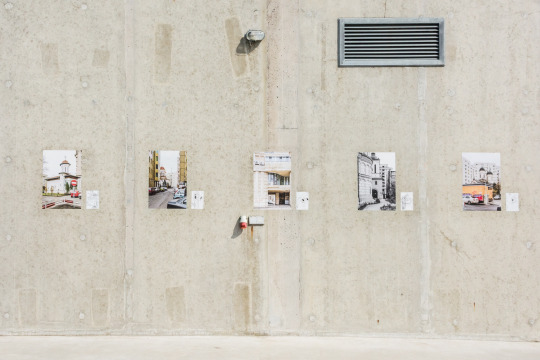
Mobile Churches, 2013–2017, 7 photographs and 7 historical sketches on wallpaper
A selection of works from the photo book Mobile Churches is on view during the group exhibition PORÖS at sculplobe in Berlin, from Aug 15–Sep 19. The show opens on August 15th 12–10 pm.
One of my concerns is the mnemonic function of places, how memories are tied to places. Mobile Churches analyses the dictatorial fantasies that manifest themselves in the urban reality of Bucharest to this day. As part of the so-called ‘systematisation’ program under Romanian dictator Ceaușescu, seven Orthodox churches were lifted, moved on rails and placed in backyards, thus erasing them from the official cityscape. However, it was not the devaluation in the consciousness of the society that was achieved, but rather an expansion from the old to the new place, which lays itself like a trace in the memory, making the churches all the more significant. If one is deprived of a concrete sight, the mental horizon widens. The efforts of an atheist regime to push the sacral buildings out of the cityscape, to demarcate them, has ultimately led to the opposite, to permeability.
In 2018, presented by Kehrer Galerie and curated by Sonia Voss, the photo series Mobile Churches was nominated for the New Discovery Award and was on view at Les Rencontres de la photographie in Arles. The book dummy of Mobile Churches was nominated for the Dummy Book Award at the Unseen Photography Festival in Amsterdam and at Les Rencontres d'Arles, both in 2017. The resulting photobook published by Kehrer Verlag, Heidelberg, was shortlisted for the Photobook Award at FOLA Fototeca Latinoamericana in Buenos Aires and also at PhotoBookAthens during the European Month of Photography at Benaki Museum in Athens.
PORÖS, August 15th–September 19th
Fadi Aljabour, David Edward Allen, Hannes Brunner, Anton Burdakov, Sunah Choi, Christoph Draeger, Kasia Fudakowski, Ingo Gerken, Sujatro Ghosh, Lise Harlev, Marie von Heyl, Daniel Hölzl, Christin Kaiser, Shila Khatami, Anton Roland Laub, Antonia Low, Katharina Ludwig, Paul McDevitt, Ulrike Mohr, Christl Mudrak, Victorine Müller, Florian Neufeldt, Olaf Nicolai, Victoria Pidust, Lucy Powell, David Rickard, Fette Sans, Max Schulze, Aiko Shimotsuma, Tommy Støckel, Halveig Villand, Ella Ziegler, Michaela Zimmer
„The new frontier is your epidermis“ writes Paul B. Preciado in his Art Forum essay Learning From The Virus and thereby points to the fact that the borders and outlines of countries, buildings and yes, bodies, are not set in stone but continuously drawn and redrawn. The permeability of the skin, Preciado seems to suggest, is not merely a biological fact, but also serves as an architectural and geographical metaphor. Conceiving of bodies, objects, territories and buildings as porous entities, however, poses the question whether the subject/object divide that we have grown so accustomed to is conceptually still feasible. Are there other ways to make sense of the world, conceptually and/or aesthetically as well as socially?
The exhibition PORÖS at Lobe Block picks up on these threads to bring together artworks, performances and interventions under the umbrella term porosity. The outdoor areas of the building become the site for installations and events that metaphorically, aesthetically or conceptually engage with the concepts of porosity and permeability.
PORÖS will be the first public event of sculplobe e.V., a non-profit association founded in 2021 by a group of artists, architects and curators in order to facilitate art projects in and around the building Lobe Block in Berlin. Sculplobe e.V. aims to create a forum for conversations between contemporary global art and the neighbourhood Wedding. Participating artists are encouraged to engage artistically and socially with the local environment.
www.sculplobe.com
Opening: August 15th 12–10 pm
Opening times: Sat/Sun 12–6 pm or by appointment [email protected]
Location: Lobe Block, Böttgerstraße 16, 13357 Berlin
Events:
August 15th 12–7 pm
: I Have Eaten So Many Diamonds They Are Now Poking Through My Skin (says Anne) - Marie von Heyl & Fette Sans will perform the porosity of bodies and language in a seven hour long conversation in a setting by Kasia Fudakowski.
August 15th 6–9 pm:
Food, Politics and Caste - A performative meal by Sujatro Ghosh (Baldon Restaurant) please contact [email protected] to make a reservation
August 15th 5 pm
: Room For A View (Daniel Hölzl with Hannes Brunner) - A performative architectural exercise in porosity as a reminder to the ambivalence of monolithic gestures
September 10th 11–3 pm
: Room For - A View (Daniel Hölzl with Hannes Brunner) - A performative architectural exercise in porosity
September 19th 6:30 pm:
Un-w/hol(e)-y - A reading performance by Katharina Ludwig weaving through the site of Lobe Block in search for an un-w/hol(e)-y, unreliable language of an environment/co-habitation that grows into a narrative choreography. Perhaps there will be props and objects involved.
September 19th 8 pm
: Dalunsch - A performance by Victorine Müller
2 notes
·
View notes
Photo


One minute of silence, 2021, triptych
The triptych from the video One minute of silence, 2021, is on view during FOTOHAUS 2021: Persona, curated by Christel Boget and Eva Gravayat. The group exhibition is part of the ÉCHOS SYSTÈME Arles Associé program of Les Rencontres de la Photographie in Arles and takes place at the Manuel Rivera-Ortiz Foundation from July 04 - September 26, 2021. The video is included in the photo film Sauver les corps, 2021, a collaborative work by the collectives LesAssociés and ParisBerlin>fotogroup.
"A persona is not what someone is in reality, but what he or she and others think they are.” – Carl. G. Jung. A persona is the mask worn by any individual to meet the requirements of social life. The FOTOHAUS 2021 theme asks the following questions: How to talk about humans in society? How are they allowed to show themselves in the eyes of others and themselves? How persona thus explores an individual’s facets to themselves and their environment, be it geographical or social. [...] The present health crisis symbolizes the physical prevention of living together and life in society. Behind the mask the persona is no longer a place of being: we are facing the void and the lack of the social game, an alibi of our existence and the rules that govern it. (from the exhibition text)
With the support of: arte, Buergerfondscitoyen, Freundeskreis Willy-Brandt-Haus Berlin, Institut français Berlin, Saft Bordeaux, Total Germany, Whitewall
0 notes
Photo





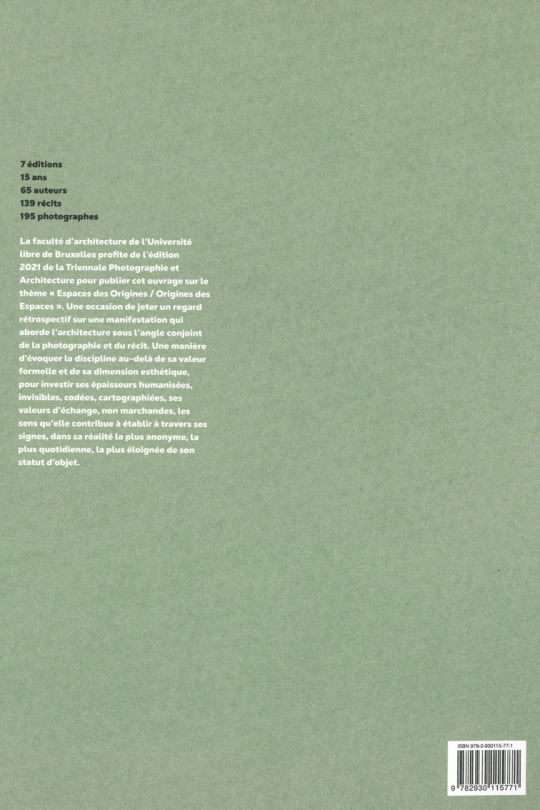
The work Mobile Churches is included in the catalogue of the 7th Triennale for Photography and Architecture, edited by Marc Mawet and published by ARP2 éditions, Bruxelles and the Faculty of Architecture of the Free University of Brussels (ULB). The photographic series is accompanied by a text contribution by Andrei Miulescu.
"The work is not interested in the original injury, destruction and trauma, but describes, contextually and objectively, the present situation of these minor fragments of architecture. The ethical questions raised revolve around the uncertain relationship between tradition and contemporaneity and around the community value of the built context. To a large extent, the work speaks of the progressive erasure of the ontological difference between form and content, between truth and post-truth. The author proposes to reflect on the problem of indifference, alienation, the disappearance of urban landmarks, oblivion and the lack of socio-cultural content of architecture.[...] The aesthetic attitude, the framing, the chromatic strength, the value and the photographic dimension of the subject, the geometric relationship between form and background, all convey a single message: the initial urban displacement has as its objective the trivialisation, the erasure of differences, the ontological uniformisation and the inversion of values."
From the essay "A project of architectural re-education" by Andrei Miulescu (translated from the French). For further information (French): https://archi.ulb.be/version-francaise/actualites/sortie-de-louvrage-espaces-des-origines-origines-des-espaces-publie-par-la-faculte-et-co-edite-avec-la-maison-dedition-arp2
In 2018, presented by Kehrer Galerie and curated by Sonia Voss, the work Mobile Churches was nominated for the New Discovery Award and was on show at Les Rencontres de la photographie, Arles.
In 2017, the dummy of the photo book Mobile Churches was nominated for the LUMA Dummy Book Award at Les Rencontres d’Arles and afterwards at Unseen Photography Festival in Amsterdam and is now part of the Archive of Les Rencontres de la Photographie d'Arles. The resulting photo book, published as a trilingual edition (De/Fr/En) by Kehrer Verlag in Heidelberg, was launched at Paris Photo and later selected for the FOLA Fototeca Latinoamericana Photobook Award in Buenos Aires and shortlisted at PhotoBookAthens during the European Month of Photography at Benaki Museum in Athens.
0 notes